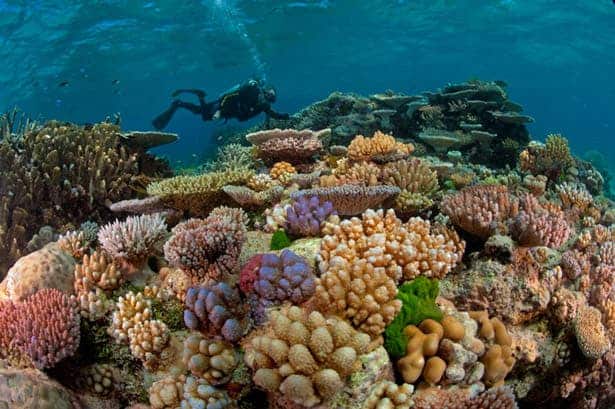
(c) David Doubilet
According to the most comprehensive study ever carried out on the World Heritage Site, findings have shown that damage caused by storms, crown-of-thorns starfish and bleaching have resulted in more than half of the amount of coral covering reefs being cut in half since 1985 and will likely continue to decline if immediate countering steps are not made.
Australia’s Great Barrier Reef is the world’s largest coral reef system, making it the biggest single structure made by living organisms. It’s so vast that it can actually be seen from space. Still, this natural wonder of the world has been hit hard in the past few decades, as much of its coral has died off, diminishing the habitat of a fragile, yet unique ecosystem. The future doesn’t fair too well, either.
In 2007, we first sounded the alarm that the Great Barrier Reef, and Pacific reefs in general, were not as pristine and resilient as a lot of people wanted to believe,” said John Bruno, a marine biology professor at the University of North Carolina Chapel Hill, who was not part of the study. “But still, this is really shocking to me.”
After reviewing 2,258 surveys of 214 reefs within the marine sanctuary, the researchers from Australian Institute of Marine Science and the University of Wollongong found a major decline in coral cover from 28 percent to 13.8 percent. “Two-thirds of that decline has occurred since 1998,” they added.
The main drivers of this severe coral genocide have been found to be tropical storms (48%), coral predation by crown-of-thorns starfish (42%) and coral bleaching (10%). Now, storms and star fish have always been part of the reef’s system, and rdinarily, reefs can recover within 10 to 20 years from storms, bleachings or starfish attacks but climate change impacts slow this down. Rising ocean acidification caused by seas absorbing more carbon dioxide is disrupting the ability of corals to build their calcium carbonate structures. Hotter seas stress corals still further. Also, as stress gathers up from warm seas or pollution bleaching, whereby coral expels the tiny single-celled algae inside that provide color, and storms intensify.
Coral reef could be halved once more in 10 years
If crucial steps aren’t met, the scientists fear the covering coral might again be halved in a mere 10 years.
“Coral cover on the reef is consistently declining, and without intervention, it will likely fall to 5 to 10 percent within the next 10 years,” say the researchers in the study published in the Proceedings of the National Academy of Sciences journal.
The researchers aren’t willing to make phantasmagorical claims of reducing global warming and such, instead they suggest a more realistic goal that will help the Great Barrier Reef at least maintain it’s current coverage, if not grow – countering starfish pests.
Starfish predation plays a big role in coral decline, and it’s primarily caused by contaminated water. Nutrient-rich waters stimulate plankton, which starfish larvae thrive on, and if fertilizer and other nutrient-rich pollution in the water is cleaned up, starfish populations would decline. Coral cover could increase by nearly a percentage point a year, estimates show. The researchers back-up their claims with an analysis of the northern Great Barrier Reef, which has little starfish predation, and showed no overall decline.









